Preamble
The goal of this page is to show what X-band satellites are receivable in this band in a presentable way, ‘demystifying’ the broadcasts. I will also include information about every individual transmission that is required to receive it.
Every satellite will have full resolution sample imagery provided from my archive. This is NOT an X-band reception guide, the scope of such a guide is way out of my depth at the moment. I have personally NOT received these and likely will not do so for a while given the high initial cost.
Introduction
X-band reception is a very advanced endeavor, given the severe lack of documentation online, high cost of entry, as well as the dedication required - You will fall flat on your face a lot! I might describe this process some day when I get enough disposable income to try it out myself, but for the time being, I will try to write out what I know fairly well already - the satellites’ broadcasts.
The minimum dish size is inapplicable to this band because of the significant variance between setups, the low margins introduced with X can make two nearly identical setups perform worlds apart because of minimal differences. Upon a suggestion from lego11, a minimum SNR for a good decode will be included instead. See below for a definition.
Formatting
Each satellite will start with a compressed preview image to roughly show what you can get, followed by a brief description of the series in question in the Description heading.
Following the description is the Signal table(s) heading which contains information about the transmission(s) in question in the following format:
Name of transmission - Potential notes
| Satellite | Frequency | Symbol rate | Polarization | FEC | Minimum SNR | Beamed | Location |
|---|---|---|---|---|---|---|---|
| Transmitting satellite(s) | S/E | S/E | S/E | Whether signal has FEC | Minimal dB needed for green RS on FEC, or enough SNR for recognizable imagery with median blur if no FEC | Whether signal is transmitted at a specific location | If beamed, location of beam. Otherwise, area where the signal is active |
S/E = Self explanatory
What follows after is some sample images in the Sample imagery heading (duh), processed or otherwise. I expect to fill this in near the end of August due to me not being home right now.
List of satellites that you can receive with SatDump
There are 22+ satellites you can receive in this band, more specifically:
- 5x FengYun 3
- 3x NOAA JPSS
- 2x Meteor-M
- 2x NASA EOS
- 3x Elektro-L*
- 2x Arktika-M*
- 1x GEO-KOMPSAT
- 2x MetOp
- 2x GOES-R* (TODO)
* Beamed - only receivable near the ground station heading (depends on how tight it is)
This list is not exhaustive, I apologize if I missed anything.
Satellite descriptions
FengYun-3
 Left: A crop of FengYun-3F received on 28/4/2025 at 09:07 UTC by Konrad Unger. Processed with the
Left: A crop of FengYun-3F received on 28/4/2025 at 09:07 UTC by Konrad Unger. Processed with the True color composite. Click here for the full resolution image. Right: FengYun-3E XEUVI received by Konrad Unger on 25/4/2025 at 14:47 UTC. Processed with SatDump, colorized using a script by lego11 found here (Xeuvize)
Description
- Fengyun 3D, 3E, 3F, 3G, and as of recently 3H all transmit their mission data in the X-band, most notably their AHRPT direct broadcast
- These satellites also dump their mission data in a transmission called DPT (Delayed Picture Transmission)
- 3D, 3E, 3F all transmit full dumps to Kiruna, partial dumps to China (to get a lower delay for the South China Sea and Oceania). China also acts like a backup if Kiruna is undergoing maintenance.
- 3G only dumps to China due to its orbit
- 3H is still commissioning, is very simmilar to 3F
- The instruments vary between the satellites, notably:
- FengYun 3E has a XEUVI for sun imaging
- FengYun 3G is in an Inclined Equatorial orbit, carries RM (Rainfall measurement) instrumentation as its payload unlike the rest of the Fengyun 3 series. It is very fast and flies very low, making it receivable with a smaller dish than the rest albeit with much more difficult tracking. It also has an unusually small symbol rate at just 6 Msym/s.
Signal tables
AHRPT
| Satellite | Frequency | Symbol rate | Polarization | FEC | Minimum SNR | Beamed | Location |
|---|---|---|---|---|---|---|---|
| FengYun 3D | 7820 MHz | 30 Msym/s | RHCP | Yes | 7 dB | No | Global |
| FengYun 3E | 7860 MHz | 38.4 Msym/s | RHCP | Yes | 7 dB | No | Global |
| FengYun 3F | 7790 MHz | 38.4 Msym/s | LHCP | Yes | 7 dB | No | Global |
| FengYun 3G | 7790 MHz | 6 Msym/s | RHCP | Yes | 7 dB | No | Global |
| FengYun 3H | 7860 MHz | 38.4 Msym/s | LHCP | Yes | 7 dB | No | Global |
DPT (Dump)
| Satellite | Frequency | Symbol rate | Polarization | FEC | Minimum SNR | Beamed | Location |
|---|---|---|---|---|---|---|---|
| FengYun 3D | 8250 MHz | 150 Msym/s | RHCP | Yes | 7 dB | No | Kiruna, China |
| FengYun 3E | 8212.5 MHz | 225 Msym/s | ??? | Yes | 7 dB | No | Kiruna, China |
| FengYun 3F | 8212.5 MHz | 225 Msym/s | ??? | Yes | 7 dB | No | Kiruna, China |
| FengYun 3G | ??? | 225 Msym/s | ??? | Yes | 11 dB | No | China |
| FengYun 3H | 8212.5 MHz | 225 Msym/s | ??? | Yes | 7 dB | No | Kiruna, China |
Sample imagery
- FengYun 3D by Konrad Unger at 14:17z on 12/7/2025
- MERSI-2
- MWRI/1
- MWHS/2 - same as FY 3E
- FengYun 3E by Konrad Unger at 16:41z on 12/7/2025
- MERSI-LL
- MWHS/2
- MWTS/3
- XEUVI (processed with xeuvize)
- FengYun 3F by Konrad Unger at 10:47z on 28/4/2025
- MERSI-3
- MWHS/2 and MWTS/3 same as FY-3E
- MWRI/2 not implemented in SatDump, TODO
- FengYun 3G by Lego11 at 16:55z on 27/2/2025
- MERSI-RM
- MWRI-RM - not implemented yet, TODO
- FengYun 3H - TODO
NOAA JPSS
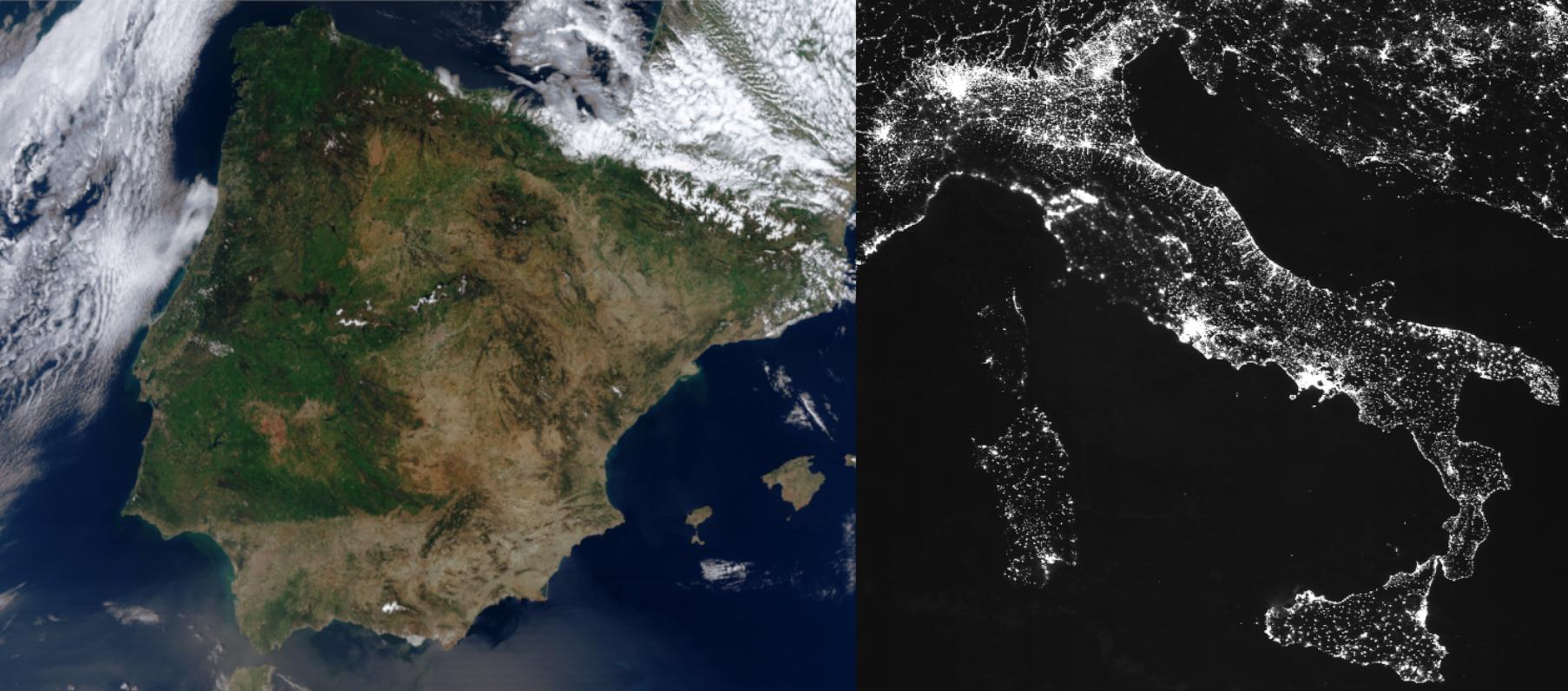 Left: NOAA 20 received on 24/4/2025 at 12:56 UTC by Konrad Unger. Processed with SatDump using the
Left: NOAA 20 received on 24/4/2025 at 12:56 UTC by Konrad Unger. Processed with SatDump using the True color composite. Cropped. Click here for the full resolution image. Right: NOAA 20 VIIRS DNB channel crop, received on 1/1/2025 at 1:05 UTC by lego11. Processed with SatDump using the DNB Night composite. Cropped. Click here for the full resolution image
Description
- Being the current-gen constellation from NOAA+NASA, all JPSS (Joint Polar Satellite System) satellites transmit in the X-band -> Suomi NPP, NOAA 20, and NOAA 21
- NOAA 20 has suffered many issues, notably a failed detector in the VIIRS (imaging) instrument causing scan lines to appear in certain composites
- The Suomi NPP satellite also has occasional issues with its clock, causing imagery to process with erroneous dates
- All satellites have a null in their antennas’ radiation pattern:
- Suomi NPP has a strong null when it’s west from your position at certain elevations
- NOAA 20 has a strong null when it’s east from your position at certain elevations
- NOAA 21’s null is still present but not as significant, improved FEC helps mitigate it further
Signal table
DB
| Satellite | Frequency | Symbol rate | Polarization | FEC | Minimum SNR | Beamed | Location |
|---|---|---|---|---|---|---|---|
| Suomi NPP | 7812 MHz | 15 Msym/s | RHCP | Yes | 6 dB | No | Global |
| NOAA 20 | 7812 MHz | 15 Msym/s | RHCP | Yes | 6 dB | No | Global |
| NOAA 21 | 7812 MHz | 25 Msym/s | RHCP | Yes | 4 dB | No | Global |
Sample imagery
VIIRS and ATMS are identical between all of JPSS. OMPS is not implemented in SatDump.
- NOAA 21 by lego11 at 12:51z on 17/8/2025
- VIIRS
- AVHRR 221
- AVHRR 3a21
- Bathymetric
- Day Land-cloud fire RGB
- Fire temperature RGB
- Panchromatic
- True color
- VIIRS I321-I221 mix
- VIIRS DNB Night - Different pass, still by lego11 but at 01:05z on 1/1/2025
- ATMS
- VIIRS
- NOAA 20 by Konrad Unger at 12:37z on 25/4/2025
- VIIRS (Identical to NOAA 21)
- ATMS - Identical to NOAA 21
- Suomi NPP - Identical to NOAA 21
Meteor-M
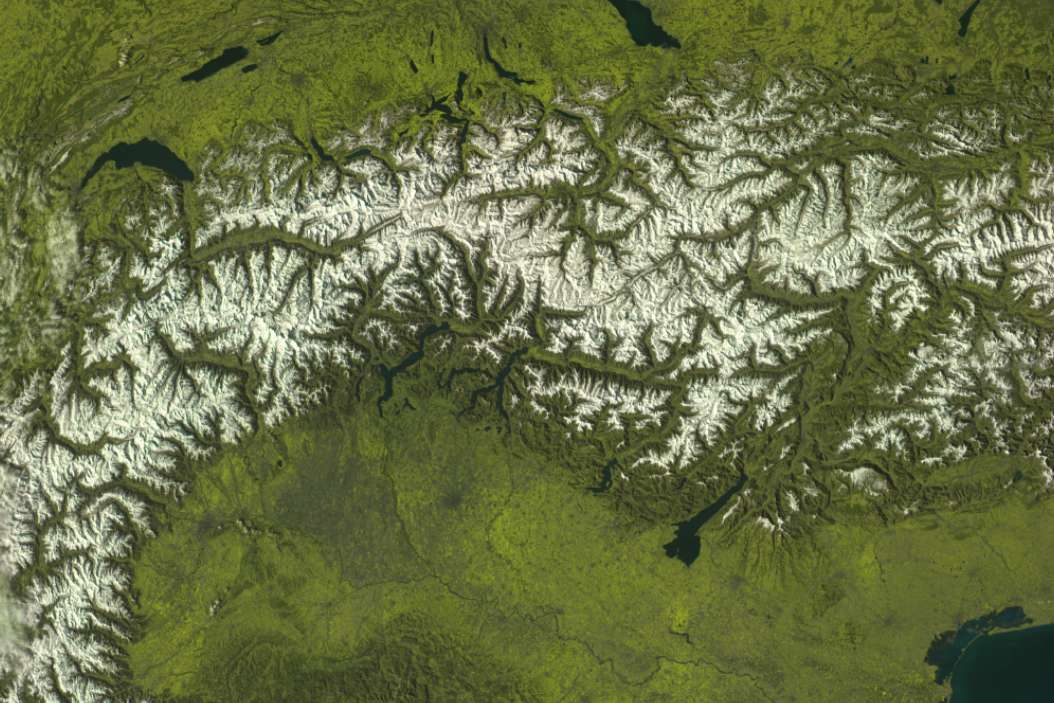 Meteor-M N°2-4 KMSS DB crop from the first MSU-100, received on 19/3/2025 at 10:51 UTC by Konrad Unger. Processed with SatDump using the
Meteor-M N°2-4 KMSS DB crop from the first MSU-100, received on 19/3/2025 at 10:51 UTC by Konrad Unger. Processed with SatDump using the Natural color composite. 60% quality lossy JPEG compression and median blur applied, click here for the full resolution image
Description
- Meteor-M N°2-3 and Meteor-M N°2-4 both transmit in the X band, dump to Russian ground stations using a NON-beamed transmission (the antenna is an open waveguide)
- Transmissions are separated into “Narrow” ones that have a ~15 MHz bandwidth and “Wide” ones which have a ~61 MHz bandwidth
- Meteor M2-3 has a failed wide X-band transmitter, making it only do narrow transmissions. This means it ONLY transmits MTVZA dumps and IKFS dumps (?)
- Meteor M2-4 transmits KMSS DB in and around Russia as well as over most of Europe, possibly the Caribbean and Brazil as well (unconfirmed)
- These satellites transmit a diverse amount of transmissions, as is seen in the tables below.
Signal Tables
MTVZA Dump (Narrow BPSK)
| Satellite | Frequency | Symbol rate | Polarization | FEC | Minimum SNR | Beamed | Location |
|---|---|---|---|---|---|---|---|
| Meteor M2-3, M2-4 | 8128 MHz | 15.36 Msym/s | RHCP | No | 2.5 dB | No | Moscow, Novosibirsk, Khabrovsk |
IKFS Dump (Narrow QPSK) - Unconfirmed, not received yet
| Satellite | Frequency | Symbol rate | Polarization | FEC | Minimum SNR | Beamed | Location |
|---|---|---|---|---|---|---|---|
| Meteor M2-3, M2-4 | ??? | 15.36 Msym/s | ??? | No | 3.5 dB | No | Khabrovsk ??? |
KMSS DB (Wide BPSK)
| Satellite | Frequency | Symbol rate | Polarization | FEC | Minimum SNR | Beamed | Location |
|---|---|---|---|---|---|---|---|
| Meteor M2-4 | 8128, 8320* MHz | 61.44 Msym/s | RHCP | No | 2.5 dB | No | Europe, Russia & its surroundings |
* 8320 MHz is rare
KMSS Dump / MSU-MR Dump / Severjanin-M + MeteoSAR Dump (Wide QPSK)
| Satellite | Frequency | Symbol rate | Polarization | FEC | Minimum SNR | Beamed | Location |
|---|---|---|---|---|---|---|---|
| Meteor M2-4 | 8320 MHz | 61.44 Msym/s | RHCP | No | 3.5 dB | No | Moscow, Novosibirsk, Khabrovsk |
Sample imagery
- TODO
NASA EOS
 Terra MODIS crop, received on 25/11/2023 at 09:35 UTC by Andrew Lorett LLC. Processed with SatDump using the
Terra MODIS crop, received on 25/11/2023 at 09:35 UTC by Andrew Lorett LLC. Processed with SatDump using the True color composite. Click here for the full resolution image
Description
- Aqua and Aura are the only satellites from the NASA EOS (Earth Observation Satellites) constellation that still transmit DB, Terra still transmits dumps but the DB signal has been disabled in 09/2024 due to a power supply issue.
- All satellites from this constellation have a null in their antenna’s radiation pattern above a ~60° elevation
- Aura only transmits the OMI instrument which is very low rate
- The dumps from these satellites are not implemented into SatDump (Encrypted?)
Signal table
DB
| Satellite | Frequency | Symbol rate | Polarization | FEC | Minimum SNR | Beamed | Location |
|---|---|---|---|---|---|---|---|
| Aqua | 8160 MHz | 7.5 MHz | RHCP | Yes | 11 dB | No | Global |
| Aura | 8160 MHz | 7.5 MHz | RHCP | Yes | 11 dB | No | Global |
Sample imagery
- Terra by Andrew Lorett LLC at 09:35z on 25/11/2023
- Aqua by Konrad Unger at 12:08z on 26/4/2025
- Aura by Lego11 at 14:30z on 22/10/2023
- OMI
Elektro-L
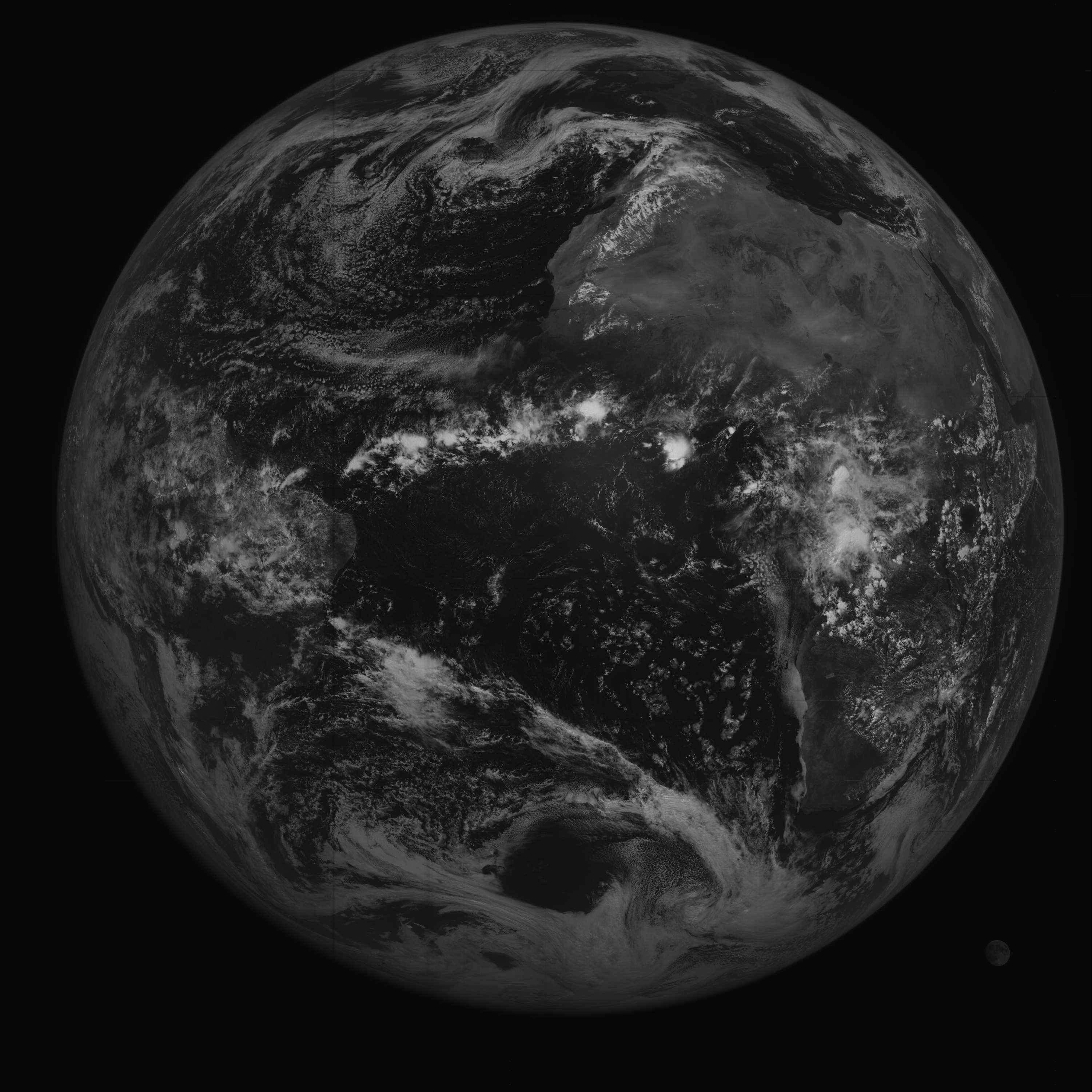 Elektro-L2 Channel 1 received on 11/4/2025 at 12:29 UTC by lego11. 60% quality lossy JPEG compression applied, image resized to 25%. Click here for the full resolution image
Elektro-L2 Channel 1 received on 11/4/2025 at 12:29 UTC by lego11. 60% quality lossy JPEG compression applied, image resized to 25%. Click here for the full resolution image
Description
- Elektro-L N°2, N°3, and N°4 all transmit a beamed RDAS signal containing all raw channels every 15 minutes (L2 every 30 minutes due to power issues)
- Elektro-L2 suffered from a severe power amplifier failure making xRIT in the L-band unusable, weakening all transmissions for a while. The satellite has seemingly recovered the transmission strength.
- L2 and L3 both beam the transmission to Moscow, L4 beams it to Vladivostok. The beam is not very tight, L2 is receivable from Europe mostly fine.
- When not actively transmitting an image, a very strong carrier is present (transmitted up until about a minute before the next transmission)
Signal table
RDAS
| Satellite | Frequency | Symbol rate | Polarization | FEC | Minimum SNR | Beamed | Location |
|---|---|---|---|---|---|---|---|
| Elektro L2 | 7500 MHz | 30.72 Msym/s | LHCP | No | 5 dB | Yes | Moscow |
| Elektro L3 | 7500 MHz | 30.72 Msym/s | RHCP | No | 5 dB | Yes | Moscow |
| Elektro L4 | 7500 MHz | 30.72 Msym/s | RHCP | No | 5 dB | Yes | Vladivostok |
Sample imagery
- Elektro-L2 Raw channel 1 - Credit to Lego11
- Elektro-L3 Raw channel 1 - Credit to Andrew Lorett LLC
Arktika-M
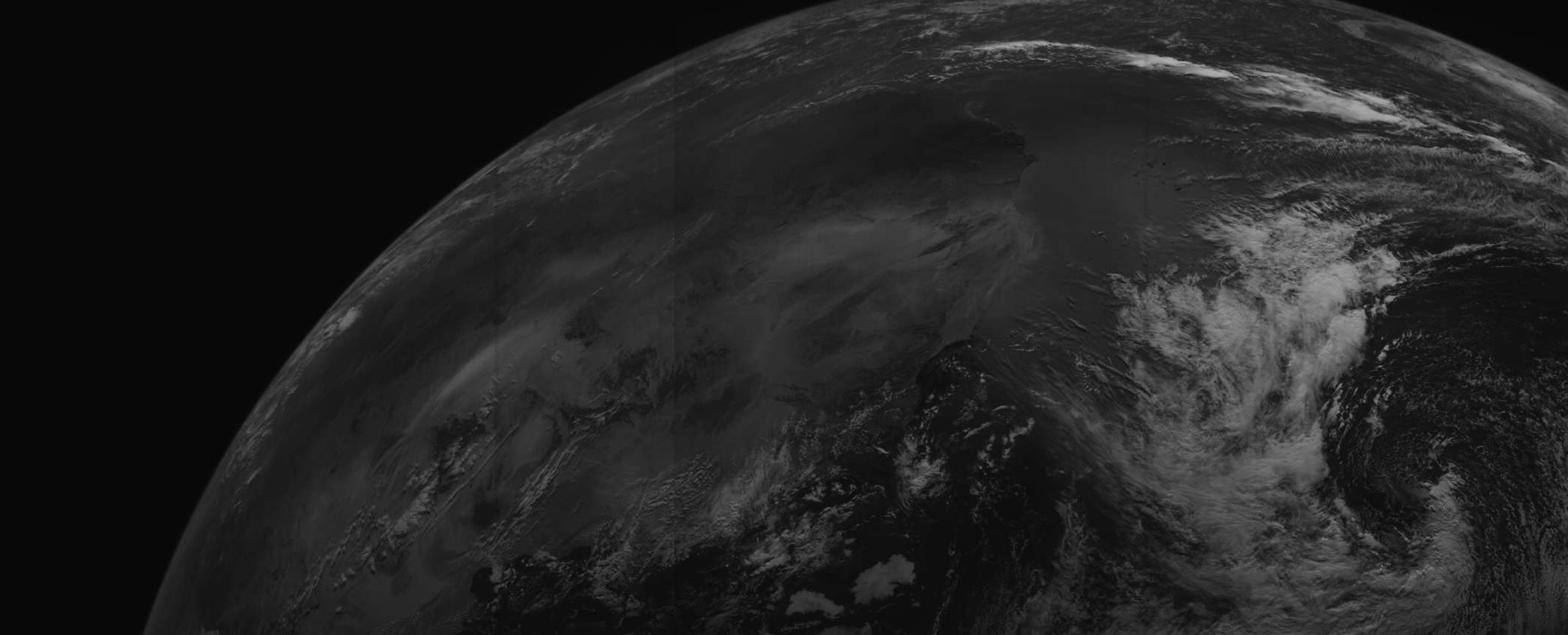 Arktika-M2 Channel 1 received on 31/12/2024 at 13:29 UTC by Andrew Lorett LLC. 60% quality lossy JPEG compression applied, image resized to 25% and cropped. Click here for the full resolution image
Arktika-M2 Channel 1 received on 31/12/2024 at 13:29 UTC by Andrew Lorett LLC. 60% quality lossy JPEG compression applied, image resized to 25% and cropped. Click here for the full resolution image
Description
- Arktika-M N°1 and Arktika-M N°2 both transmit beamed RDAS during their apogee to Moscow and Vladivostok (depending on which apogee the satellite is currently in - one is above the atlantic, the other is above the Bering Strait)
- The broadcast is identical to that of Elektro-L satellites, because Arktikas are the same bus; just shot into a molnyia orbit.
- The transmission is much weaker than that of Elektros’ because of the significantly higher apogee of the molnyia orbit.
Signal table
RDAS
| Satellite | Frequency | Symbol rate | Polarization | FEC | Minimum SNR | Beamed | Location |
|---|---|---|---|---|---|---|---|
| Arktika-M1, M2 | 7865 MHz | 30.72 Msym/s | RHCP | No | 5 dB | Yes | Moscow, Vladivostok |
Sample imagery
- Arktika-M N°2 raw channel 1 - Credit to digitelektro
GEO-KOMPSAT
 GEO-KOMPSAT 2A True Color, received on 12/10/2025 at 03-47 UTC by plugger-lockett (Drew). 60% quality lossy JPEG compression applied, click here for the full resolution image
GEO-KOMPSAT 2A True Color, received on 12/10/2025 at 03-47 UTC by plugger-lockett (Drew). 60% quality lossy JPEG compression applied, click here for the full resolution image
Description
- GEO-KOMPSAT2A downlinks all of its 16 raw channels using an UHRIT transmission in real time
- This transmission is not beamed, should be receivable throughout the satellite’s footprint
- The satellite also has an auxiliary raw sensor downlink that hasn’t been received or decoded yet
Signal tables
UHRIT
| Satellite | Frequency | Symbol rate | Polarization | FEC | Minimum SNR | Beamed | Location |
|---|---|---|---|---|---|---|---|
| GEO-KOMPSAT 2A | 8070 MHz | 15.63 Msym/s | LHCP | Yes | 10 dB | No | Global |
Raw sensor downlink - Not received or supported
| Satellite | Frequency | Symbol rate | Polarization | FEC | Minimum SNR | Beamed | Location |
|---|---|---|---|---|---|---|---|
| GEO-KOMPSAT 2A | 8300 MHz MHz | 65 Msym/s | RHCP | Yes | ??? | ??? | ??? |
Sample imagery
- True color - Credit to plugger-lockett
- 600 nm channel (highest res) - Credit to plugger-lockett
MetOp
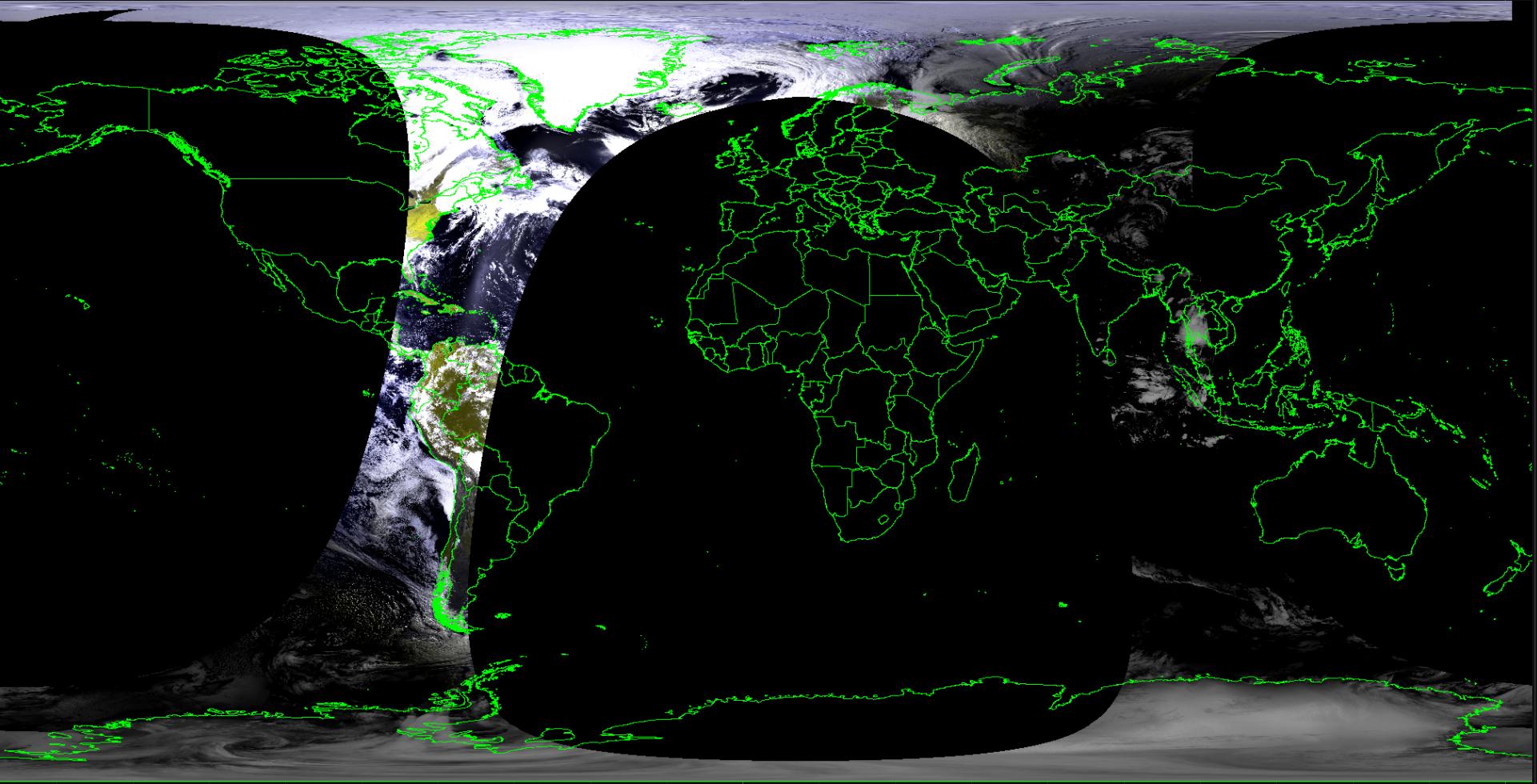 Metop-B AVHRR/3 from a dump, received on 10/5/2025 at 15:12 UTC by Andrew Lorett LLC. Processed with SatDump using the
Metop-B AVHRR/3 from a dump, received on 10/5/2025 at 15:12 UTC by Andrew Lorett LLC. Processed with SatDump using the 4/221 merge composite, projected. Click here for the full resolution image dump (not a projection since my computer can’t do 1 km/px projections)
Description
- Both MetOp-B and MetOp-C dump their whole orbit to Svalbard on every pass, this dump includes all instruments just like in the [L-band] AHRPT transmission - in essence the transmission is just faster AHRPT
- Future satellites will be a part of the MetOp-SG constellation which will also transmit in the X-band, albeit at a significantly higher symbol rate
Signal table
Dump
| Satellite | Frequency | Symbol rate | Polarization | FEC | Minimum SNR | Beamed | Location |
|---|---|---|---|---|---|---|---|
| MetOp-B, MetOp-C | 7800 MHz | 35 Msym/s | RHCP | No | 5 dB | No | Svalbard |
Sample imagery
Epilogue
I hope you found this page helpful in describing what you can receive in the X-band. If you are interested in knowing how to receive these signals, I recommend you check lego11’s X-band primer out. Please note that it’s not a tutorial for beginners, given how difficult this band is to receive!